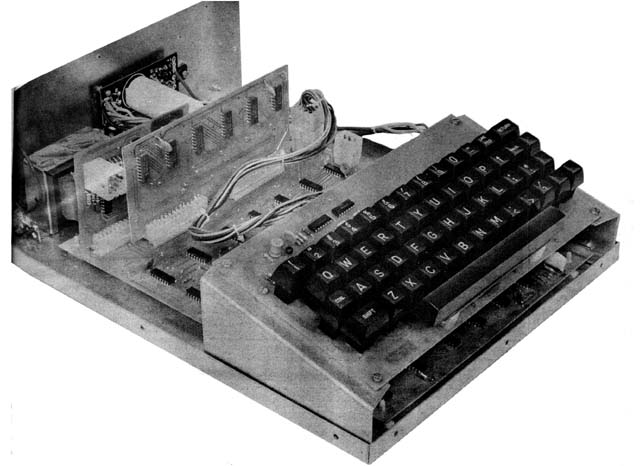

After seeing the overwhelming response shown for the TV typewriter story featured in the September 1973 issue of Radio Electronics magazine, it is obvious that there are many readers interested in these units. As described in the previous article, there are many uses for a display such as this with the possibilities limited only by the imagination of the user.
One of the biggest applications of these units, however, is for data communications with computers. Combined with a keyboard, we have one of the fastest and most efficient means for an individual to communicate with a machine. An excellent example is the Mark 8 minicomputer shown on the front cover of the July 1974 issue of Radio Electronics magazine. You can be sure that more powerful and more economical units will follow. Then of course, if you don't have or don't want your own machine, you can always tie into a full size time shared system, assuming you have access to one.
If you tried to build the terminal in the September 1973 issue, you probably discovered as many did that although the printed circuit boards were commercially available, some of the semiconductor chips were rather difficult to get. For this reason, this terminal has been built using 74 series TTL IC's that are common, easy to get, and inexpensive. The only MOS chips used are 2102 RAM's (Random Access Memories) and a 2513 character generator. And just to make things really easy, the unit is available as a complete kit including circuit boards, IC's, discrete components, interconnectors and optional power supply. A cabinet, however, is not being made available at this time. Since in most cases you will want to use the TV typewriter in combination with a keyboard of some kind to enter messages, the supplier of the TV typewriter is making available a low cost compatible keyboard/ encoder too.
To make the unit as flexible as possible, extra effort has gone into designing plug on options including a manually operated cursor control board, a computer operated plug on board, screen read board and a URT communications board.
The basic character organization is very similar to the original TV Typewriter, in that there are sixteen lines of 32 characters, however, this unit has a second page of memory as part of the basic unit rather than as optional accessory, providing a total character memory of 1024 characters.
Since the FCC is very rigid in their requirements for transmitters in the television frequencies, the unit has been designed to be connected directly to the input to the video amplifier of a standard television set.
Although any set may be used, the small screen black and white portables give the best picture. The connections are simple and a jack can, be provided to allow switching between terminal and normal television operation.
Automatic carriage return is provided after the last character of each line, returning the Cursor to the beginning of the next line. Unless switched off, a blinking cursor always shows where the next character is to go and you have the option of writing on either one of two pages of memory which are independently selected and displayed on the screen, through the PAGE SELECT switch. This same switch also provides automatic carry over of the cursor from one page to the other when the end of frame is reached; or when selected, automatically performs a "home up" (return to line 1 column 1) of the same page. Erase to end of line (EOL) and erase to end of frame (EOF) functions are also provided. When enabled, they perform the erase function from the cursor location on the page selected. Line feed and carriage return are provided as well: with a line feed being a binary 0001010 or a control J, and a carriage return as a binary 0001101 or a control M.
| DATA FORMAT | 1024 characters arranged as 2 pages of sixteen lines of 32 characters each. |
| OUTPUT | 2.25 volt video pulse 1 volt sync pulse compatible with the video input of a standard television or video monitor. The display's response must be to 1.6 MHz for maximum character size and to 3 MHz for minimum character size and should be flat to 4.5 MHz for best appearance. |
| INPUT | 7 bit parallel ASCII positive logic with a key press strobe that may be either positive or negative going. |
| CONTROLS | Page select Home up (moves cursor to upper left hand corner) Erase to end of line Erase to end of frame Cursor on off Linefeed Carriage return Adjustable left hand margin positioning Adjustable character size |
| POWER REQUIREMENTS | 5 Vdc, 2A, 5% regulation; 5 Vdc, 15mA; 12 Vdc, 20mA. |
| SIZE | 12" long x 9 3/4" wide x 3 1/2" high. |
| ACCESSORIES | Manual cursor control board. Computer cursor control board. Screen read board (allows transfer of accumulated data to an outside device should be used with the cursor control and URT boards). URT board (receives and transmits data in RS 232 format using 7 bit ASCII code at 110, 220, 440, or 880 baud or if a different crystal is used 150, 300, 600, or 1200 baud). |